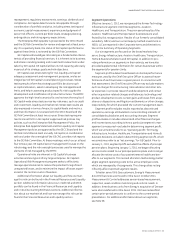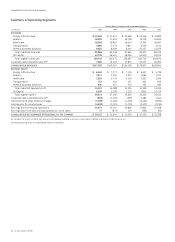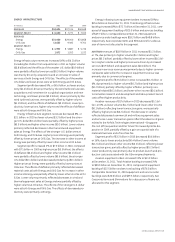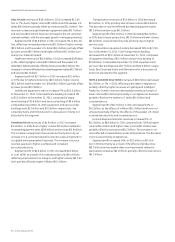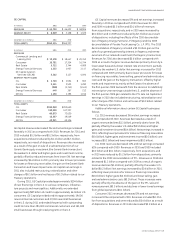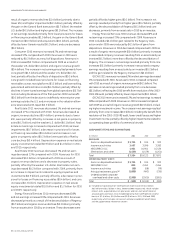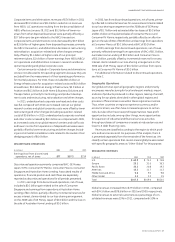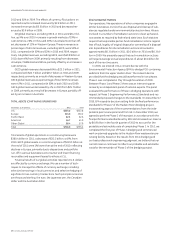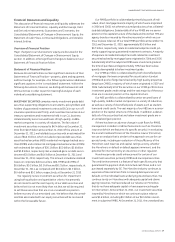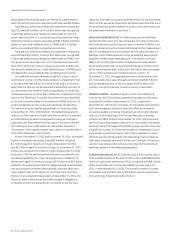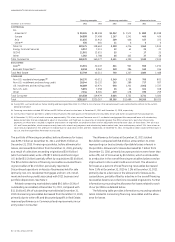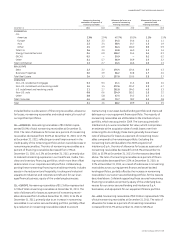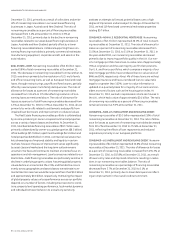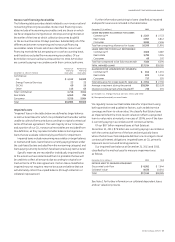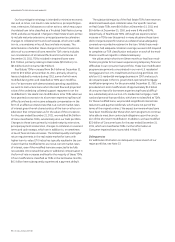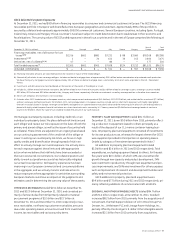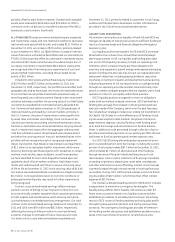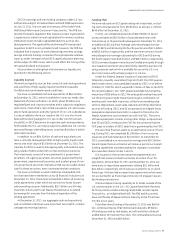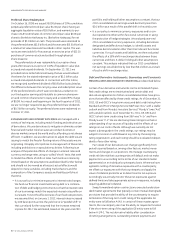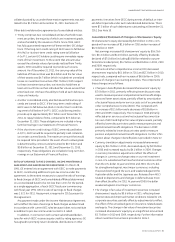GE 2011 Annual Report Download - page 53
Download and view the complete annual report
Please find page 53 of the 2011 GE annual report below. You can navigate through the pages in the report by either clicking on the pages listed below, or by using the keyword search tool below to find specific information within the annual report.’
GE 2011 ANNUAL REPORT 51
INVENTORIES for GE totaled to $13.7 billion at December 31, 2011,
up $2.3 billion from the end of 2010. This increase refl ected higher
inventories at Energy Infrastructure, partially due to acquisitions
($1.0 billion), Aviation and Transportation. GE inventory turnover
was 7.0 and 7.2 in 2011 and 2010, respectively. See Note 5.
FINANCING RECEIVABLES is our largest category of assets and
represents one of our primary sources of revenues. Our portfolio
of fi nancing receivables is diverse and not directly comparable to
major U.S. banks. A discussion of the quality of certain elements
of the fi nancing receivables portfolio follows.
Our consumer portfolio is largely non-U.S. and primarily com-
prises mortgage, sales fi nance, auto and personal loans in various
European and Asian countries. Our U.S. consumer fi nancing
receivables comprise 16% of our total portfolio. Of those, approxi-
mately 65% relate primarily to credit cards, which are often
subject to profi t and loss-sharing arrangements with the retailer
(the results of which are refl ected in revenues), and have a smaller
average balance and lower loss severity as compared to bank
cards. The remaining 35% are sales fi nance receivables, which
provide electronics, recreation, medical and home improvement
fi nancing to customers. In 2007, we exited the U.S. mortgage
business and we have no U.S. auto or student loans.
Our commercial portfolio primarily comprises senior, secured
positions with comparatively low loss history. The secured receiv-
ables in this portfolio are collateralized by a variety of asset
classes, which for our CLL business primarily include: industrial-
related facilities and equipment, vehicles, corporate aircraft, and
equipment used in many industries, including the construction,
manufacturing, transportation, media, communications, entertain-
ment and healthcare industries. The portfolios in our Real Estate,
GECAS and Energy Financial Services businesses are collateral-
ized by commercial real estate, commercial aircraft and operating
assets in the global energy industry, respectively. We are in a
secured position for substantially all of our commercial portfolio.
Losses on fi nancing receivables are recognized when they are
incurred, which requires us to make our best estimate of probable
losses inherent in the portfolio. The method for calculating the
best estimate of losses depends on the size, type and risk char-
acteristics of the related fi nancing receivable. Such an estimate
requires consideration of historical loss experience, adjusted for
current conditions, and judgments about the probable effects of
relevant observable data, including present economic conditions
such as delinquency rates, fi nancial health of specifi c custom-
ers and market sectors, collateral values (including housing price
indices as applicable), and the present and expected future lev-
els of interest rates. The underlying assumptions, estimates and
assessments we use to provide for losses are updated periodi-
cally to refl ect our view of current conditions. Changes in such
estimates can signifi cantly affect the allowance and provision for
losses. It is possible to experience credit losses that are different
from our current estimates.
Our risk management process includes standards and policies
for reviewing major risk exposures and concentrations, and eval-
uates relevant data either for individual loans or fi nancing leases,
or on a portfolio basis, as appropriate.
Loans acquired in a business acquisition are recorded at fair
value, which incorporates our estimate at the acquisition date
of the credit losses over the remaining life of the portfolio. As a
result, the allowance for losses is not carried over at acquisition.
This may have the effect of causing lower reserve coverage ratios
for those portfolios.
For purposes of the discussion that follows, “delinquent” receiv-
ables are those that are 30 days or more past due based on their
contractual terms; and “nonearning” receivables are those that
are 90 days or more past due (or for which collection is otherwise
doubtful). Nonearning receivables exclude loans purchased at a
discount (unless they have deteriorated post acquisition). Under
FASB ASC 310, Receivables, these loans are initially recorded at
fair value and accrete interest income over the estimated life of
the loan based on reasonably estimable cash fl ows even if the
underlying loans are contractually delinquent at acquisition. In
addition, nonearning receivables exclude loans that are paying on
a cash accounting basis but classifi ed as nonaccrual and impaired.
“Nonaccrual” fi nancing receivables include all nonearning receiv-
ables and are those on which we have stopped accruing interest.
We stop accruing interest at the earlier of the time at which col-
lection of an account becomes doubtful or the account becomes
90 days past due. Recently restructured fi nancing receivables are
not considered delinquent when payments are brought current
according to the restructured terms, but may remain classifi ed as
nonaccrual until there has been a period of satisfactory payment
performance by the borrower and future payments are reasonably
assured of collection.
Further information on the determination of the allowance
for losses on fi nancing receivables and the credit quality and cat-
egorization of our fi nancing receivables is provided in the Critical
Accounting Estimates section and Notes 1, 6 and 23.


